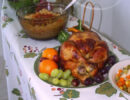by Elaine Mizuo
Whether it’s a sweet smile from a baby, a happy smile of a child, a casual smile between strangers, or a contagious smile between friends, a great smile can go a long way. The average woman smiles about 62 times a day. Kids laugh around 400 times a day. Everyone loves smiles. How do you keep that smile at its very best? Here are a few tips to help you.
Parents play a key role in ensuring that their child’s teeth are clean and healthy. The goal should be healthy teeth for life.
For babies:
- Proper dental care begins even before you see your baby’s first tooth. By the time your baby is born, most of the baby teeth are already formed but are not seen since they are still inside the baby’s gums. Carbohydrates from formula, milk, and juices cause bacteria to grow in your baby’s mouth, so after a feeding, make it a goal to gently wipe your baby’s gums with a soft, clean, damp washcloth to keep bacteria growth down.
- From the time that first adorable tooth appears, wipe it with clean gauze after every meal—well, at least try….
- When more teeth appear, use a soft baby toothbrush to clean the teeth after every meal, (it can be a goal you work towards).
- Don’t let your baby or toddler use a baby bottle or a sippy cup filled with formula, milk, juice, or other sugary beverages as a pacifier during waking hours. If you do, it will bathe the teeth in sugars all day long, resulting in tooth decay.
- If a baby bottle or sippy cup is used at bedtime or nap time, fill it with only water. Then you will prevent the bacteria from eating away at your baby’s teeth during sleeping hours.
- The first visit to the dentist should be around your child’s first birthday.
For children:
- See the dentist twice a year for regular check-ups. Start when your child is young so that it becomes a natural part of your child’s yearly routine for a lifetime.
- Allow your child to choose a cute or colorful child-sized toothbrush with soft bristles.
- Find toothpaste in a flavor that your child likes. Many are safely formulated for children under age 3.
- Brush after each meal. This is the best practice, but at least after breakfast and dinner.
- Once your child has learned not to swallow toothpaste, use one with fluoride.
- Use only a pea-sized amount of fluoride toothpaste with children under age 7, especially if your child is still prone to swallowing some of the toothpaste.
- Have your child brush before going to bed as part of the nightly bedtime routine.
- Eat healthy snacks and limit starchy foods, such as chips and sweet foods and sweet drinks, because they stick to the teeth.
- Adults should brush and floss their child’s teeth until the child is capable of doing a thorough job without adult help. Children lack the fine motor skills that are necessary to do it correctly, and will need help with brushing until age 8.
- Flossing is important but even trickier than brushing, and often requires adult help until age 10. Avoid pushing the floss into the gum as the gum can be split and damaged from improper flossing.
When brushing:
- Be gentle but thorough. How long you brush can be measured by counting to 7 as you brush each side of a tooth in a circular motion.
- Hold your toothbrush at a 45-degree angle as you brush your gum lines and use short straight strokes.
- Brush the inner and outer sides of each tooth.
- Brush the flat chewing surfaces of each tooth, and turn your toothbrush vertically to get the backs of your top and bottom front teeth.
- Brush the roof of your mouth, the inside of your cheeks, and lastly, your tongue.
- It’s a good idea to try and replace toothbrushes every 3 months.
For adults:
- Be a good role model to your children and try brushing alongside them as they brush their own teeth.
- Brush twice a day with a fluoride toothpaste.
- Floss daily to remove plaque before it forms tartar, which can only be removed by a dentist.
- Use of antibacterial mouth rinses reduces bacteria in the mouth that cause plaque and gum disease.
- Unsweetened cranberry juice can be used as a natural alternative mouth rinse. Studies suggest that this unsweetened juice kills on contact the bacteria that causes tooth decay, and can help to rid teeth of plaque.
- Eat healthy foods and limit snacking on sugary and starchy foods.
- Visit your dentist every 6 months for a checkup and teeth cleaning.
Take care of those beautiful teeth, and remember to give a smile and catch a smile everyday. It can be just the thing to make your day – and someone else’s too!
An Experiment
What happens to teeth that are not brushed and cared for properly? Here’s a simple experiment to see what can happen.
- Place a whole egg, shell and all, in a bowl of vinegar for a day. What do you see happening?
- Take the egg out of the vinegar. Does the shell still feel hard?

Young Girl Brushing Her Teeth 
Young Girl Brushing Her Teeth
After we eat, the bacteria in our mouth breaks food down into acids that can eat away at our teeth just like the vinegar ate away at the eggshell. We can protect our teeth from becoming soft and weak by brushing daily with a fluoride toothpaste.









